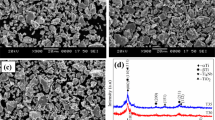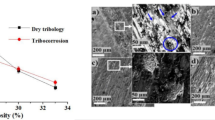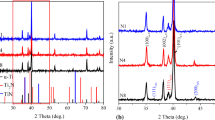Abstract
Porous Ti–20Nb–5Ag (wt.%) alloy was developed using powder metallurgy (PM) route with the porosity of 43% after sintering in a high vacuum atmosphere. The microstructure of the porous alloy revealed various micro, macro and interconnected pores with an average pore size of about 114 µm. Tribocorrosion behaviour of the porous alloy was examined in simulated body fluid under the various applied load of 1–10 N using DC electrochemical corrosion technique and kinetic parameters (corrosion potential, corrosion current density and breakdown potentials). After tribocorrosion test, the OCP values decreased from 0.17 to − 0.49 VSCE as applied load was increased. The potentiodynamic polarization results revealed that the corrosion potential decreased, while corrosion current density increased under higher applied loads. Active–passive transition plots showed metastable passivity due to severe fluctuations of passive current density. After tribocorrosion, the surface morphology was analysed using SEM, and it exhibited the severity of wear tracks at higher applied loads. The results indicated that the developed porous Ti–20Nb–5Ag alloys exhibit better tribocorrosion properties in simulated body fluid. Through observations of SEM images of the worn surfaces, the visible scratches and deep grooves were observed along the sliding direction, indicating a predominant abrasive mechanism.






Similar content being viewed by others
References
Gao et al (2012) Mechanical modulation and bioactive surface modification of porous Ti–10Mo alloy for bone implants. Mater Des 42:13–20
Hsu HC et al (2015) Fabrication and characterization of novel porous titanium microspheres for biomedical applications. Mater Charact 106:317–323
Runa MJ et al (2013) Tribocorrosion response of the Ti6Al4V alloys commonly used in femoral stems. Tribiology Int 68:85–93
Torres-Sanchez C et al (2018) Porosity and pore size effect on the properties of sintered Ti35Nb4Sn alloy scaffolds and their suitability for tissue engineering applications. J Alloys Compd 731:189–199
Hsu HC et al (2010) Formation of calcium phosphates on low-modulus Ti–7.5Mo alloy by acid and alkali treatments. J Mater Sci 45:3661–3670
Spoerke ED et al (2005) A bioactive titanium foam scaffold for bone repair. Acta Biomater 1:523–533
Xiong J et al (2008) Mechanical properties and bioactive surface modification via alkali-heat treatment of a porous Ti–18Nb–4Sn alloy for biomedical applications. Acta Biomater 4:1963–1968
Mathew MT et al (2010) Tribocorrosion behaviour of TiCxOy thin films in bio-fluids. Electrochim Acta 56:929–937
De Assis SL et al (2006) Corrosion characterization of titanium alloys by electrochemical techniques. Electrochim Acta 51:1815–1819
Mathew MT et al (2011) Tribocorrosion behavior of CoCrMo alloy for hip prosthesis as a function of loads: a comparison between two testing systems. Wear 271:1210–1219
Fatehi K et al (2008) In vitro biomimetic deposition of apatite on alkaline and heat treated Ti6Al4V alloy surface. Bull Mater Sci 31:101–108
Aguilar C et al (2016) Synthesis and characterization of Ti–Ta–Nb–Mn foams. Mater Sci Eng C 58:420–431
Stráský J et al (2017) Increasing strength of a biomedical Ti–Nb–Ta–Zr alloy by alloying with Fe, Si and O. J Mech Behav Biomed Mater 71:329–336
Liu Q et al (2013) α′ type Ti–Nb–Zr alloys with ultra-low Young’s modulus and high strength. Prog Nat Sci Mater Int 23:562–565
Rao X et al (2014) Phase composition, microstructure, and mechanical properties of porous Ti–Nb–Zr alloys prepared by a two-step foaming powder metallurgy method. J Mech Behav Biomed Mater 34:27–36
Nazari KA et al (2015) Mechanical properties and microstructure of powder metallurgy Ti–xNb–yMo alloys for implant materials. JMADE 88:1164–1174
Lee CM et al (2002) Structure–property relationship of cast Ti–Nb alloys. J Oral Rehabil 29:314–322
Hou L et al (2013) Fabrication and characterization of porous sintered Ti–Ag compacts for biomedical application purpose. J Mater Sci Technol 29:330–338
Lee B et al (2014) Space-holder effect on designing pore structure and determining mechanical properties in porous titanium. Mater Des 57:712–718
Shivaram MJ et al (2020) Electrochemical corrosion and impedance studies of porous Ti–xNb–Ag alloy in physiological solution. Trans Indian Inst Met 73:921–928
Pina VG et al (2016) Microstructural, electrochemical and tribo-electrochemical characterisation of titanium–copper biomedical alloys. Corros Sci 109:115–125
Mathew MT et al (2009) Significance of tribocorrosion in biomedical applications: overview and current status. Adv Tribol. https://doi.org/10.1155/2009/250986
Stack MM et al (2011) Tribology international some views on the construction of bio-tribo-corrosion maps for titanium alloys in Hank’s solution: particle concentration and applied loads effects. Tribiol Int 44:1827–1837
Wang Z et al (2018) Tribocorrosion behavior of Ti–30Zr alloy for dental implants. Mater Lett 218:190–192
Diomidis N et al (2012) Tribo–electrochemical characterization of metallic biomaterials for total joint replacement. Acta Biomater 8:852–859
More NS et al (2011) Tribocorrosion behavior of β titanium alloys in physiological solutions containing synovial components. Mater Sci Eng C 31:400–408
Dimah MK et al (2012) Study of the biotribocorrosion behaviour of titanium biomedical alloys in simulated body fluids by electrochemical techniques. Wear 295:409–418
Toptan F et al (2017) Biomedical materials tribocorrosion behavior of bio-functionalized highly porous titanium. J Mech Behav Biomed Mater 69:144–152
Vats V et al (2018) Tribo-corrosion study of nickel-free, high nitrogen and high manganese austenitic stainless steel. Tribol Int 119:659–666
Tk Ã, Takadama H (2006) How useful is SBF in predicting in vivo bone bioactivity? Biomaterials 27:2907–2915
Wang Z et al (2017) Tribocorrosion behaviour of a biomedical Ti–25Nb–3Mo–3Zr–2Sn alloy in Ringer’s solution. Mater Sci Eng C 76:1094–1102
Yenal S et al (2013) Tribocorrosion behavior of duplex treated pure titanium in simulated body fluid. Wear 302:1642–1648
Toptan F et al (2016) Corrosion and tribocorrosion behavior of Ti–B4C composite intended for orthopaedic implants. J Mech Behav Biomed Mater 61:152–163
Toptan F et al (2019) Corrosion and tribocorrosion behaviour of Ti6Al4V produced by selective laser melting and hot pressing in comparison with the commercial alloy. J Mater Process Technol 266:239–245
Huang W et al (2015) Wear and electrochemical corrosion behavior of biomedical Ti–25Nb–3Mo–3Zr–2Sn alloy in simulated physiological solutions. J Bio Tribo Corros 1:1–10
Fellah M et al (2019) Preliminary investigation on the bio-tribocorrosion behavior of porous nanostructured β-type titanium based biomedical alloys. Mater Lett 257:126–129
Guo X et al (2017) Corrosion and electrochemical impedance properties of Ti alloys as orthopaedic trauma implant materials. Int J Electrochem Sci 12:9007–9016
Vishnu DSM et al (2018) Electrochemical synthesis of porous Ti–Nb alloys for biomedical applications. Mater Sci Eng C 96:466–478
Zhang BB et al (2008) Effect of Ag on the corrosion behavior of Ti–Ag alloys in artificial saliva solutions. Dent Mater 25:672–677
Shivaram MJ et al (2020) Development and characterization of biomedical porous Ti–20Nb–5Ag alloy: Microstructure, mechanical properties, surface bioactivity and cell viability studies. Metals Mater Inter. https://doi.org/10.1007/s12540-020-00915-2
Acknowledgements
One of the authors, Mr. Shivaram M. J., would like to thank the Ministry of Human Resource Development (MHRD), Government of India for providing research fellowship. He would also like to thank Dr. Rahul B. Mane, (IIT Hyderabad) and Mr. Gurudath B. (NITK Surathkal) for their partial assistance in preparing the porous alloy samples. SB Arya another author would like to thanks Department of Science and Technolgy, Govt. of India.
Author information
Authors and Affiliations
Corresponding author
Additional information
Publisher's Note
Springer Nature remains neutral with regard to jurisdictional claims in published maps and institutional affiliations.
Rights and permissions
About this article
Cite this article
Shivaram, M.J., Arya, S.B., Nayak, J. et al. Tribocorrosion Behaviour of Biomedical Porous Ti–20Nb–5Ag Alloy in Simulated Body Fluid. J Bio Tribo Corros 7, 59 (2021). https://doi.org/10.1007/s40735-021-00491-x
Received:
Revised:
Accepted:
Published:
DOI: https://doi.org/10.1007/s40735-021-00491-x




